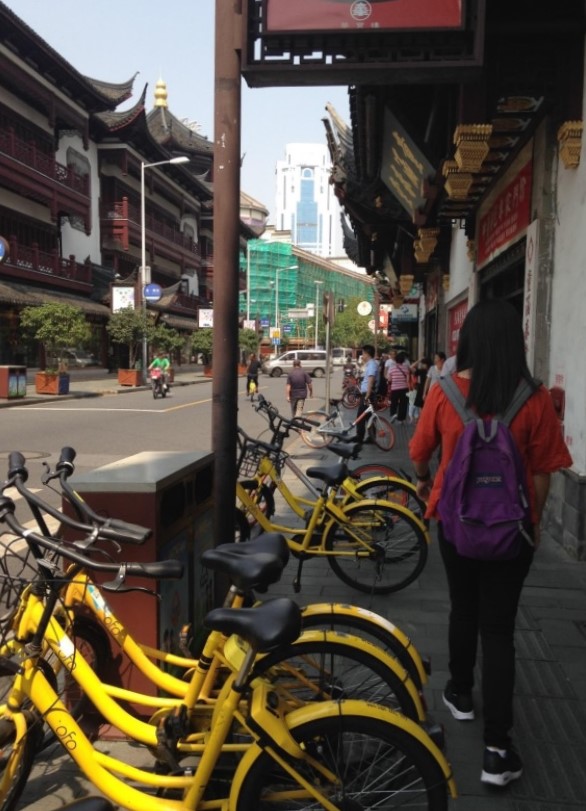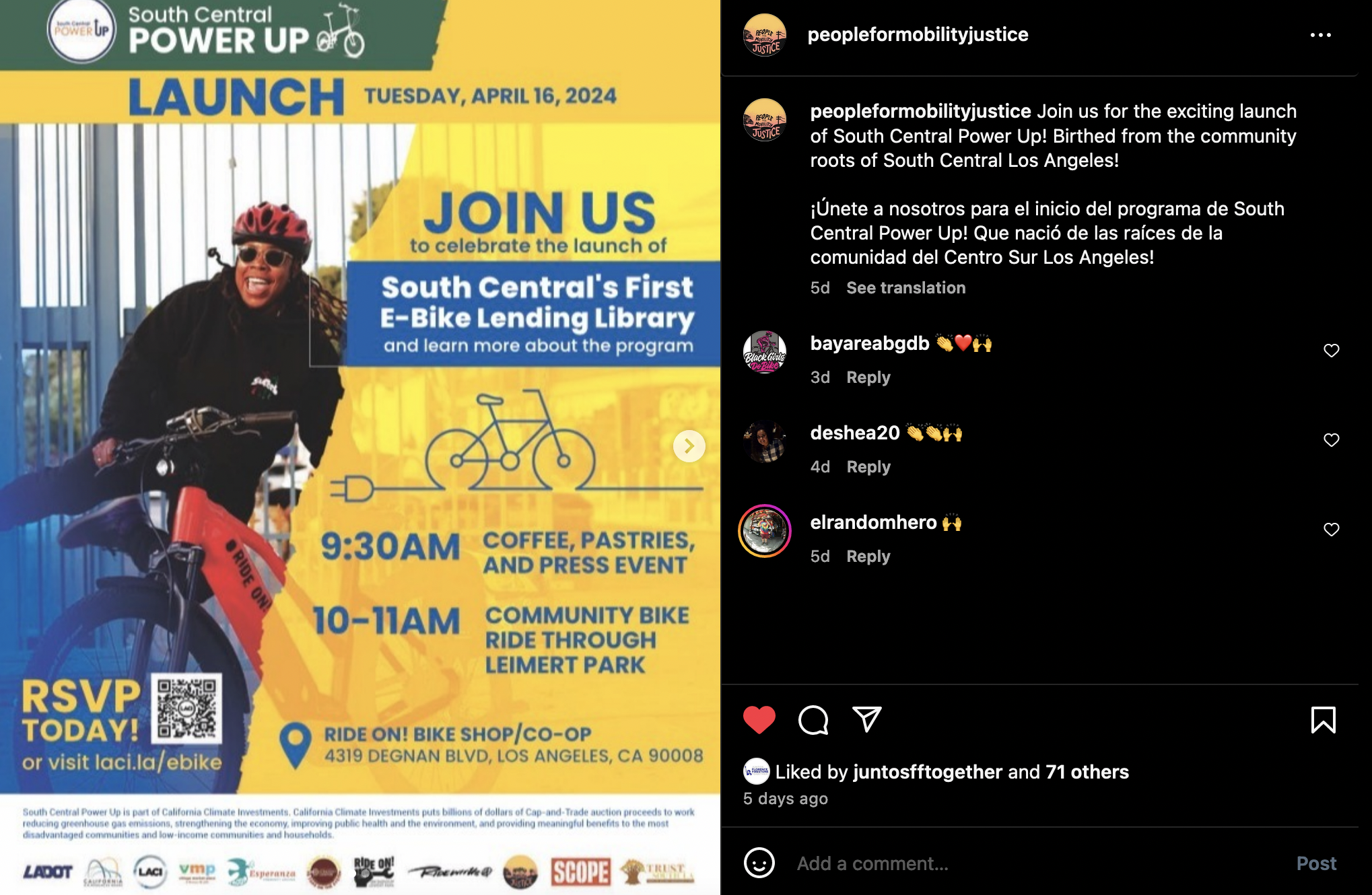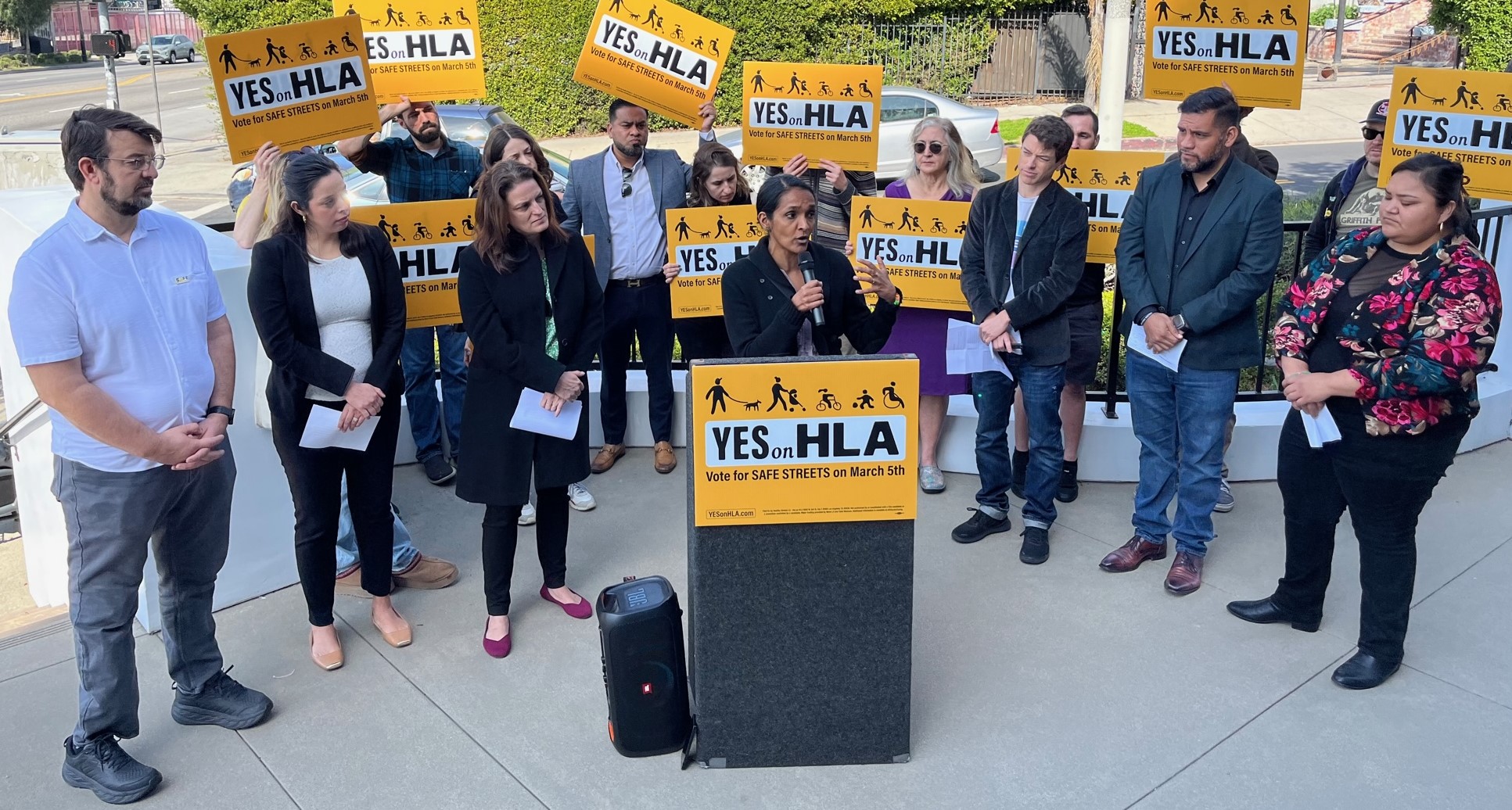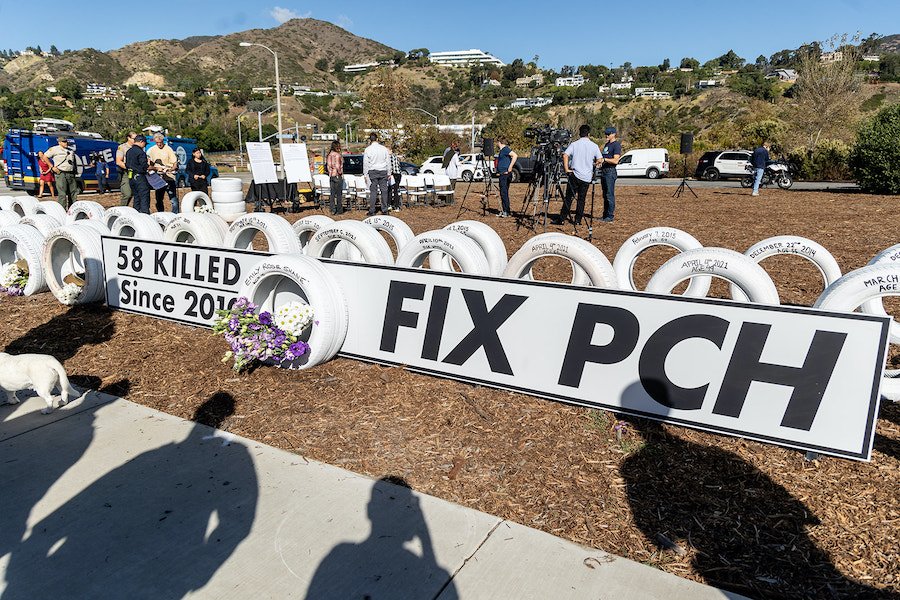
Dockless Shared Bikes in Shanghai. Photo courtesy of the author
When I returned to China last month to give some talks about my new book, it was my first visit in over two years. When I arrived in Shanghai, I was astounded by the vehicle street scene. There were still lots of cars competing for space and continuing traffic jams. But the most striking visual change were the thousands of yellow and orange and other color bikes in the streets that hadn’t been there two years earlier. They were jostling for space with cars, parked everywhere on the sidewalks, in dedicated bike lanes, and part of the flow of traffic. On the bikes were students, young professionals, working people, middle aged women, and even septuagenarians.
It’s China’s latest bike revolution – dockless shared bikes – and the budding entrepreneurs who initiated it, now backed by some of China’s largest tech investors like Alibaba, want to bring it to the U.S., and also to Los Angeles!
After I came back to the states and spoke about China’s instantaneous bike revolution, a common response was, “oh, that’s China; it’s a different bike culture over there. They are the Bicycle Kingdom.”
That perception does not entirely correspond to China’s own complex history with bikes. Before 1949, bikes were nearly non-existent in China. After 1949 and for more than 50 years until the 1990s, China did become known as the “Kingdom of Bicycles.” During this period, bikes became the primary transport mode, especially during the 1950s through the 1970s where the majority of the urban population was organized into danwei, or work units, that connected the workplace with housing, and facilitated the idea of short-distance travel.
When China transitioned to more of a market economy in the 1990s, bike use began to decline. Bike production, however, took off, thanks to China’s rapid growth of manufacturing centers, especially for export. As bike use declined, the streets increasingly became dominated by the automobile and bike traffic fatalities increased. Due to the growing number of cars, Chinese cities widened their streets and converted bike lanes to mixed-traffic service roads with fast-moving auto traffic, leading to a further increase in bicycle fatalities even as overall bike use declined.
In the 1990s, Chinese cities further deemphasized bike commuting to the point that bike use was banned in some urban areas to make way for the automobile and its association with modernity. Chinese urban planners described cycling as a “second-rate mode of transport,” and complained that cyclists got in the way of motor traffic. “Improved efficiency of junctions can only be achieved by taking the cyclists out of the equation,” the planners argued, asserting that cycling’s image was “inappropriate to a World City at the forefront of the technological revolution.”
However, the image of a “world city” as being supportive of bicycle infrastructure has led to a renewed interest in bike use in several Chinese cities in recent years. Some cities reversed their approach on banning bikes by building new bike lanes and identifying the positive health and environmental benefits of bike riding. The 2008 Olympics in Beijing and 2010 Expo events in Shanghai helped stimulate the new interest in bike infrastructure and bike use, as those cities presented themselves to global audiences. New dock-based bike-share programs were instituted and even surpassed other programs around the world, given the Chinese government’s speed in introducing new developments. Bike lanes that had been eliminated began to be restored, and even a Vice Minister in the Ministry of Construction, Qiu Baoxing, argued that it was important for China to regain its reputation as the “Kingdom of Bicycles.”
Nevertheless, until my trip last month I found that despite the new interest in bike sharing, restored bike lanes, and other bike-related initiatives, bike riding had continued to decline in China while car use had continued to skyrocket. Domestic bike production remained limited, while the manufacturing sector continued to emphasize exports. China flooded the U.S. market with cheaper bikes and even forced the major bike producer in the United States to move its production activities overseas. Up to 2013, nearly two-thirds of China’s bike production revenues were earmarked as exports, in contrast to the United States where 99 percent of the bikes in use are imports, with many of those (as many as 70 percent) coming from China.
One of the striking visual discrepancies in China that I found in my earlier visits was the contrast of people riding older bikes along the edge of a wide major thoroughfare occupied by new cars. China’s megacities such as Beijing and Shanghai continued to experience an explosion of car buying, congested roads, a squeeze on available land, and air quality impacts. This transformation continued to reflect the development of the Chinese auto industry into one of the “pillar industries” for economic development.
What has happened then in a period of no more than 12-18 months? In the summer of 2016, a recent graduate of Peking University expanded his initial foray into dockless bikes at Peking U. to develop the Ofo company with its dockless signature yellow bikes. That same year, the former Shanghai head of Uber decided to venture into the dockless bike world by starting a new company, MoBike with its brand of dockless orange bikes.
The bike system that Ofo and MoBike offered, soon to be joined by several other copycat systems, was simple, yet radical in its impact. China had recently developed its own robust bike-share system with hundreds of docking stations in nearly every major metropolitan area. The docked bike system was expanding, as in other countries, but still limited in numbers and subject to certain limitations as to where and how to access the bikes. The Ofo and MoBike initiatives transformed the biking scene in the cities by blanketing each place with thousands of bikes, spread throughout the city’s neighborhoods and sidewalks.
The way to access the dockless shared bike system provided an easy fit for the way China’s urban population is used to access information and pay for services. Users download an app that tells where to find a shared bike. The bike is then unlocked by scanning a QR code on a cell phone while China’s WeChat or Alipay systems can directly pay for the bike’s use. Bikes, available in multiple places, can also be left anywhere once the ride is done. Each bike has a smart lock system that leaves the bike securely for the next rider. The minimal cost is another major factor, aside from convenience, for its extraordinary rapid adoption. For the Ofo Company, it’s one yuan per thirty minutes, or the equivalent of 15 cents. For some companies, a deposit is required, often as little as 30-40 yuan, to allow for unlimited rides over as long as a year’s time. Free specials to increase brand ridership have also been offered. And although the brand is identified by the bike’s color, at least one company has begun to explore a branding connection with the Disney company.
By the time I arrived in China in September, the situation had been transformed into a sea of bike colors on the sidewalks and in the streets, contending with China’s notorious car traffic. According to government figures, China now has around 70 bike-sharing brands, which have put more than 16 million bicycles on streets nationwide and attracted over 130 million users.
The reasons for their popularity are apparent. The system is ideal for short trips – the "first/last mile" to and from a destination – whether a short commute, from the metro or bus stop, to do shopping, or a neighborhood activity. It also addresses the concern about personal bikes being stolen – a concern especially for students. “I had three bikes stolen in the past year,” Fudan University student Feng Julan told me. “This system allows me to ride without that concern.”
When I spoke at gatherings in Shanghai and Beijing, I asked the audience whether they used the dockless shared bikes. Literally at each event, everyone raised their hands. When I asked if it reduced their car use, about 50 percent said it did. The government has recognized that research is still needed to assess that type of information. Even more important is the recognition by government officials that bike-share usage data could become part of an overall municipal or neighborhood planning process. Bike-share payment information could inform other mobility planning, such as where to site new transit stops in China’s rapidly expanding subway systems.
Companies like Ofo and MoBike were able to expand so rapidly because investment capital from several of China’s largest funds embraced the dockless bike-share idea. Upwards of $1 billion flowed to the companies to expand the number of bikes on the road and to begin to search for new markets outside China as well, including in the UK and the U.S.
Initially approaching cities outside China in an Uber-like fashion (without consultation and pushing against any regulation) turned out to be a non-starter in the U.S. As a consequence, the approach of the companies has changed, including the efforts of a couple of U.S. copycats, Lime Bike and Spin, started by Bay Area entrepreneurs. For one, a number of U.S. cities now have their own bike share systems, albeit with docking stations. According to Governing magazine, about 60 U.S. cities run bike sharing programs. The trade organization, the National Association of City Transportation Officials, has estimated that the number of rides on U.S. bike sharing services–including Boston’s Hubway, Chicago’s Divvy, Washington D.C.’s Capital Bikeshare–topped 28 million in 2016. New York’s CitiBike program, the nation’s largest, provides more than a million rides a month.
The city of Los Angeles is a late starter to bike sharing programs. After a couple of false starts, a Los Angeles system was initiated as a pilot program in downtown Los Angeles in July 2016 by the Metropolitan Transportation Authority (Metro), in partnership with Bicycle Transit Systems which manages a number of bike share programs around the U.S. It has since expanded to a number of other places, including Pasadena and Venice. Metro conceives of the system as complementing its rail program by locating some of the docking stations near rail stops. Metro argues that the program is bound to develop not as quickly as other U.S. cities like Washington DC or New York City, given the region’s spread out nature, car-centric transportation modes, and more than seventy five years of a car-dominated message that the automobile represents the most convenient, cheapest, and quickest way to get from place to place, especially home to work.
The spread out region argument is perhaps the most difficult challenge for the bike share proponents. Yet as some demographers and planners have pointed out, Southern California is the densest metropolitan region (SMSA) in the U.S. Suburbs have become denser than their counterparts in other metropolitan areas. When the focus turns to short trips as opposed to long commutes, cars become not only less efficient but far more expensive. Short trips also produce major environmental impacts. And L.A.’s great bugaboo – congestion – is primarily a short trip phenomenon, as, for example, what one experiences leaving Santa Monica towards West L.A. any time after 3 p.m.
Ofo, MoBike, Lime Bike, SPIN, and a few other dockless shared bike proponents have now made some inroads in the U.S. Seattle worked out an arrangement after its own dock-based bike-share system collapsed. Washington DC decided to phase in several hundred dockless shared bikes to complement rather than compete with its own successful docking station approach. A few smaller cities, including Worcester, Massachusetts, welcomed a relationship to allow them to launch bike-share programs where they had not been before.

So why wouldn’t a city want to welcome a dockless shared bike program with open arms?
For one, if they are as successful (and revolutionary) as they have been in China, they come with a myriad of problems. They create clutter, particularly on sidewalks, when the companies involved do not have an effective system to pick up and redistribute the bikes. They are inexpensive bikes to produce and can be prone to breaking down and left in places where users simply discard them once the problem occurs. If they are simply a private enterprise, Uber-like phenomenon, they can create mixed outcomes to counter any other transport planning strategies, including but not limited to bike planning. They can be pedestrian-unfriendly, if sidewalks become obstacle courses. Their inexpensive rental price – nearly everyone I spoke to in China saw it as a great advantage responsible for its extraordinary expansion – could conceivably lead to what the Ofo co-founder called a potential “China bike bubble.”
But, as China’s government (both the central government and some of the cities like Shanghai) have decided, regulations can also be instituted that tackle those problem aspects, such as requiring companies to redistribute bikes (to reduce the clutter and sidewalk barriers) and pick up discarded ones. In the U.S., the focus has been primarily on phasing in the systems to address the problems as they present themselves. The rental price for the first set of dockless shared bikes is more expensive than in China but still considerably cheaper than docking station bikes. The dilemma is that the very scale in which they have been introduced in China (seen as an impossible goal in the U.S.) has also been a measure of their success. When bikes are available everywhere and thousands and hundreds of thousands ride them, they create a new reality – a shared space that previously had been inconceivable. It could also address one of the central criticisms of the existing bike-share approach – that the more limited access and higher prices create an equity dilemma; they are not truly available for everyone and tend to be more tourist rather than resident focused.
How to reach the promise of the dockless shared bike revolution is the challenge for those wishing to change our car-centric reality. Instead of just limited arrangements and sponsor-driven systems, we need a way to direct the discussions of what gets introduced to the larger goal of what the bike movement has long argued as its ultimate goal: to figure out and encourage how people can get on their bikes and get to where they want to go, no matter where they live, work, play, shop, go to school, or just decide that they want to ride. Shared bikes, whether dockless or with docking stations and organized with that goal in mind, can help make that happen.
Robert Gottlieb is the author (with Simon Ng) of Global Cities: Urban Environments in Los Angeles, Hong Kong, and China. He is the founder and former executive director of the Urban & Environmental Policy Institute which helped organize the ArroyoFest event nearly fifteen years ago when the 110 (Pasadena Freeway) was closed for a bike ride and a walk ON the freeway!
Stay in touch
Sign up for our free newsletter
More from Streetsblog Los Angeles
This Week In Livable Streets
CicLAvia returns to Venice Boulevard, Metro board committees, L.A. City Council Transportation Committee, Metro budget theater, and more
Measure HLA Is Now Officially Law for L.A. City
Check the city maps to find what bus, bike, and walk improvements are coming to streets in your neighborhood




